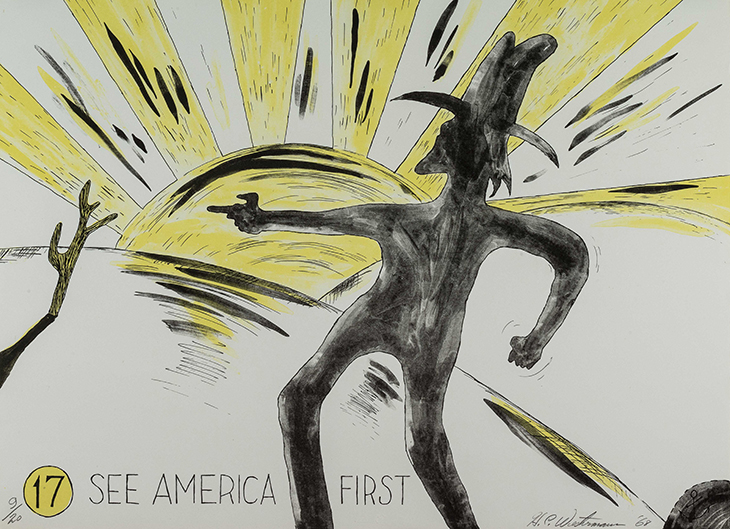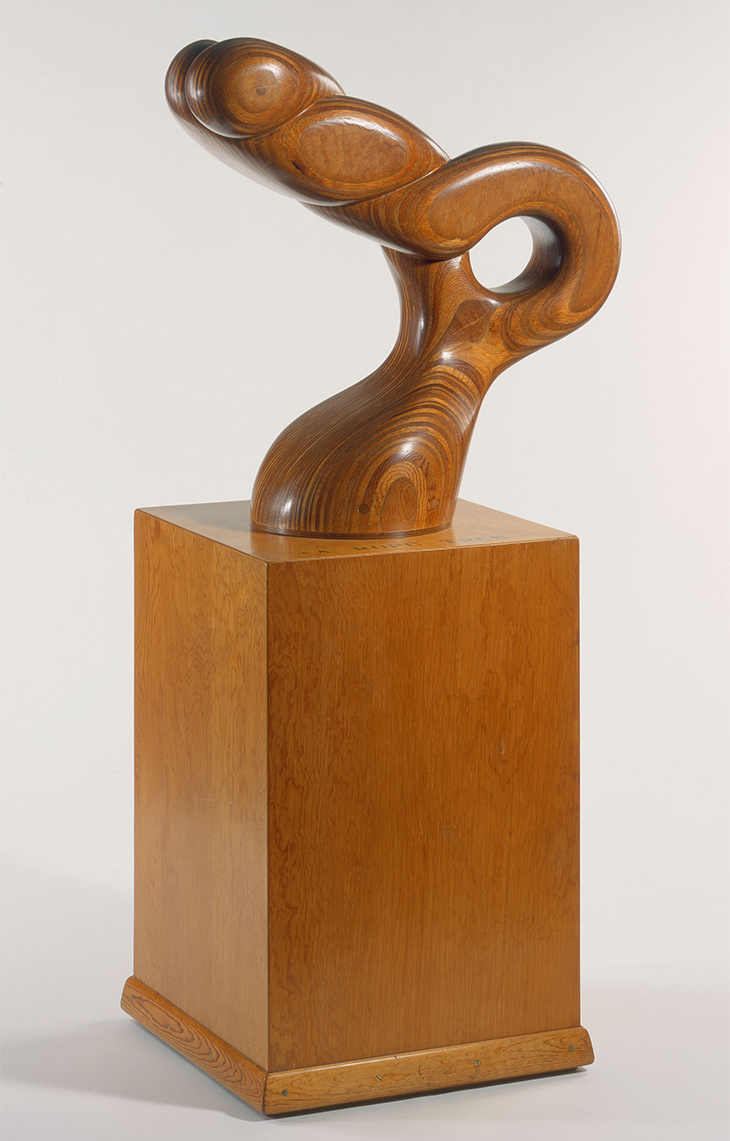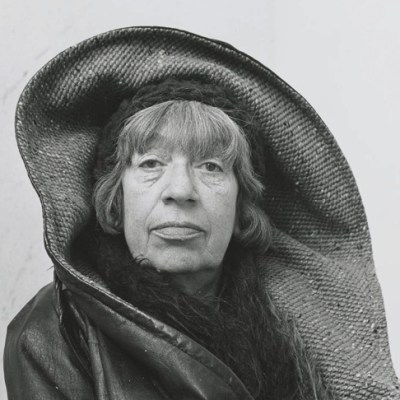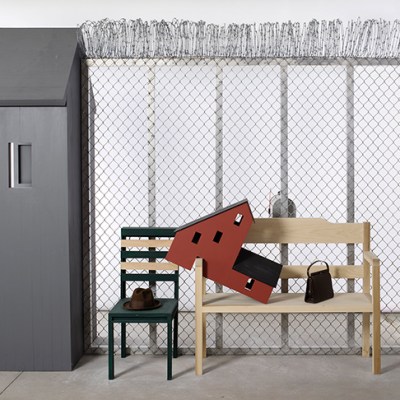Drawn by a 22-year-old H.C. Westermann (1922–81) at the close of the Second World War, Sudden Air Attack – U.S.S. Enterprise is the earliest work on display in ‘Goin’ Home’, a survey dedicated to the American artist at the Reina Sofía in Madrid. The frantic sketch depicts a surprise kamikaze attack against the aircraft carrier on which Westermann had been a marine gunner since 1943. It establishes one of Westermann’s central motifs off the bat, that of the ill-fated ‘death ship’, as well as the socially engaged, autobiographical and in some senses anachronistic nature of his work. It is pervaded by the same sense of imminent dread as was Otto Dix’s Lens Being Bombed of 1924. A later lithograph series, See America First (1968), brings to mind George Grosz’s raging satires of life in the Weimar Republic. The settings of the Pacific and Oklahoma register each work as distinctly American, yet they are clearly connected to a European precedent.
Untitled #17 from the series See America First (1968), H.C. Westermann, Photo: © 2018 courtesy the David and Alfred Smart Museum of Art, The University of Chicago. © Dumbarton Arts, LLC/Licensed by VAGA at Artists Rights Society (ARS), NY/VEGAP, Madrid, 2019

Conversations around Westermann’s work – this is its first major outing in Europe – have been dominated by the question of how exactly he fitted into the artistic canon of post-war New York, which had replaced Paris as the epicentre of the art world and where artists were establishing radically new formal languages in declaration of America’s independence from the Old World. In 1965 Donald Judd pronounced the ‘inherited format’ of illusionism among ‘the most objectionable relics of European art’ from which Abstract Expressionism, and later minimalism, would endeavour to break free. Yet he was surprisingly willing to praise the work of Westermann, which has variously been compared to Surrealism, Dada and Pop art, for its ‘emotional and philosophical content’ – perhaps a reflection of Judd’s aversion to categorisation and his belief that, with ‘almost no groups’ among American sculptors, ‘things were wide open again’. In his singular way, Westermann was indeed expanding notions of what sculpture could be. Still, against a world anchored in abstraction, it is hard not to read the Los Angeles-born Westermann’s decision in 1961 to move from Chicago, where he studied at the School of the Art Institute, to the small town of Brookfield in Connecticut – and not New York – as pointed and symbolic.
A Rope Tree (1963), H.C. Westermann. Milwaukee Art Museum. Photo: Larry Sanders. © Dumbarton Arts, LLC. Licensed by VAGA at Artists Rights Society (ARS), NY/VEGAP, Madrid, 2019

‘Goin’ Home’ addresses this context in a partial restaging of Westermann’s solo show at Allan Frumkin’s New York gallery in 1963 and by quoting Judd’s admiration for the exhibited ‘objects in their own right’, in particular A Rope Tree (1963), a visual pun in which plywood imitates a knotted rope which itself recalls a tree. Perhaps because of the museum’s geographical remove from the US, however, questions of categorisation are refreshingly sidestepped in favour of a focus on Westermann’s obsessions with dwelling and death, which the exhibition connects to the philosophical writing of Martin Heidegger.
While Westermann was onboard the U.S.S. Enterprise, he witnessed and helped clean up a devastating attack on the U.S.S. Franklin, which went up in flames, killing more than 800 crew and burning its image on Westermann’s mind forever. In 1951 he interrupted his studies in Chicago when he re-enlisted with the Marines for the Korean War before returning to school as a beneficiary of the GI Bill. Haunted by ‘the horrible smell of death’, he repeatedly returned in drawing, painting and sculpture to the image of a ‘death ship’ – often abandoned or unmoored, the doomed vessel drifts through a sea of slow suspense, punctuated by shark fins. At other times the end is in sight, as with Untitled (Walnut Death Ship in a Chestnut Box) (1974), a plain dark boat that has already been trapped inside a coffin pierced by a plane.
Memorial to the Idea of Man If He Was an Idea (1958), H.C. Westermann. Photo: Nathan Keay © MCA Chicago; © Dumbarton Arts, LLC. Licensed by VAGA at Artists Rights Society (ARS), NY/VEGAP, Madrid, 2019

Roving the endless expanse of water, the ships feel hopelessly far from its home port. More stable abodes offer little respite. In a room filled with towers and mausoleums (the exhibition is organised by theme rather than chronology), what appears at first glance like a village of twee dollhouses is up close far more sinister. The Mysteriously Abandoned New Home (1958) is boarded up with question marks lingering in the upstairs windows. Suicide Tower (1965) is a tall building encircled by a flight of stairs that seems never-ending, delaying death until it suddenly cuts off. Exterior surroundings are sometimes difficult to differentiate from the interior self, as in Mad House (1958), in which body parts disassemble and mix incongruously across the building’s façade. In this way, the spaces where we take refuge become prisons, an idea expressed allusively – the tiny figure trapped in the mouth of the fortress-headed Memorial to the Idea of Man If He Was an Idea (1958) – and explicitly, as in the man confined within the open head of He-Whore (1957), an untouched rope ladder his only hope of escape.
I’m Goin’ Home on the Midnight Train (1974), H.C. Westermann. © Dumbarton Arts, LLC. Licensed by VAGA at Artists Rights Society (ARS), NY/VEGAP, Madrid, 2019

In his essay ‘Building Dwelling Thinking’ (1951), Heidegger portrays man’s state as dwelling rather than living, as building and occupying a space in an ongoing process by which he gets closer to ‘home’. It is an uneasy state: if existing is dwelling, then what is home? According to Heidegger, ‘mortals dwell in that they initiate their own essential being – their being capable of death as death’. Echoing this idea, Westermann became transfixed by the last words – ‘I’m goin’ home’ – of a man who died by suicide in San Francisco in 1965. They became a ubiquitous reference to dying in his work and in one instance he evoked them during a period of near-fatal illness in 1974. I’m Goin’ Home on the Midnight Train, a double-headed hammer, is a functionally useless object, a symbol of the artist’s inability to continue working. The implication is clear. Producing art was Westermann’s personal dwelling, and to live without it was equivalent to death.
‘H.C. Westermann: I’m Goin’ Home’ is at the Museo Reina Sofía, Madrid, until 6 May.



